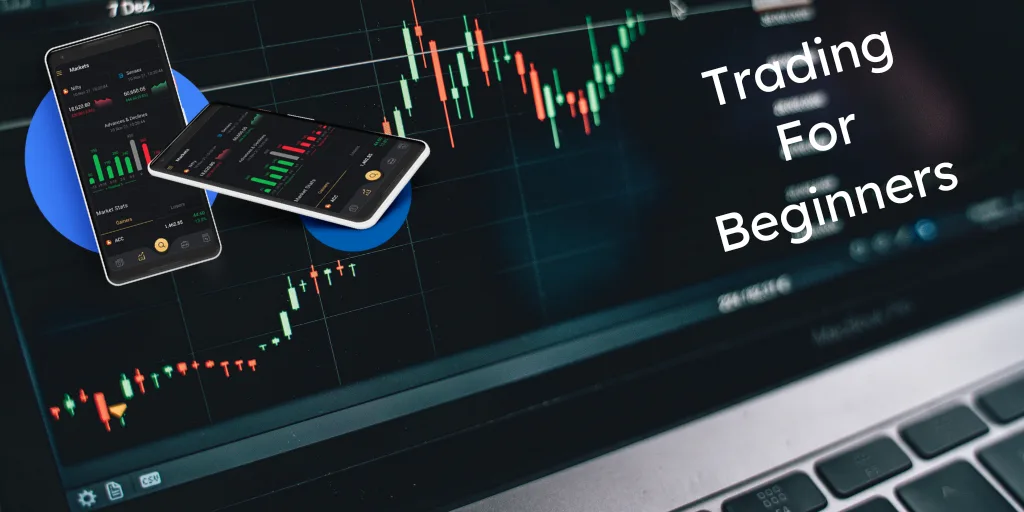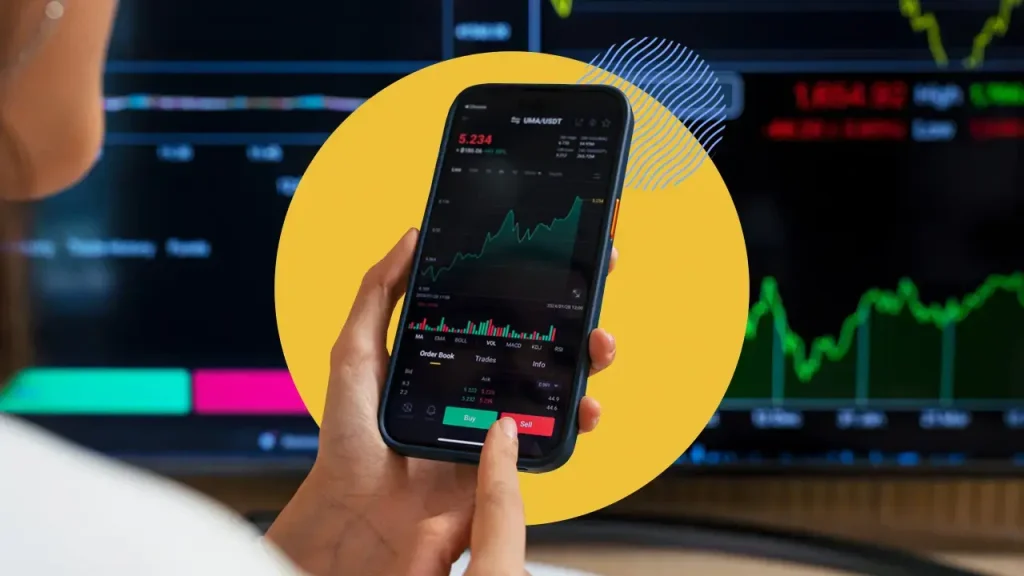
Trading For Beginners: Have you ever been curious about making money by buying and selling stocks, currencies, or commodities? That is the whole point of trading. Trading is simply buying and selling financial instruments to make a profit. It is key for personal finance, allowing you to grow wealth, attain financial independence, and even start a career. But before you dive into the markets, it’s critical to understand the basics.
Trading is more than just a way to make quick money—strategies, discipline, and knowledge of market trends are all key to success. It doesn’t matter if you’re passionate about stock trading, forex or crypto—knowing the skills which really matter can help you get rid of risk and know the best decisions to make.
We put this beginner’s guide together to help you get started on your trading journey with confidence. Let’s begin and discuss trading for beginners!
Contents
- 1 What is Trading?
- 2 Pros & Cons: Trading For Beginners
- 3 Different types of trading for beginners
- 4 How to start trading for beginners—step-by-step guide
- 5 Important terms of trading for beginners
- 6 Best tips & tricks for trading for beginners
- 7 Final Words
- 8 FAQs: Trading For Beginners
- 8.1 1. How does trading work & what is it?
- 8.2 2. How should beginners start trading?
- 8.3 3. What is a demo account, and why should it matter?
- 8.4 4. How much money do you need to start trading?
- 8.5 5. What are the dangers of trading?
- 8.6 6. What is the difference between a bull market and a bear market?
- 8.7
What is Trading?
Trading is the buying and selling of financial assets such as stocks, forex, commodities, or cryptocurrencies to make a profit. It is a significant part of the financial markets, by which individuals and businesses trade on the change of price of an asset. And the concept of trading is simple—you buy low and sell high to make a profit. Also, traders and investors are often confused by beginners, but they are diverse. Investing targets the long run, during which an individual purchases assets and holds them for years. Trading, in contrast, is short-term and involves the frequent buying and selling of assets. Different traders use tools to follow trends, measures, higher and lower prices, and so on.
Pros & Cons: Trading For Beginners
Here are the pros and cons of Trading For Beginners:
PROS:
- Profitability Potential: You can make good money in trading, and in some cases more than traditional investments.
- Flexibility: You select your own market, trading style, and frequency of trading.
- Low Entry Point: Many places online make it so new traders can start with little funds.
- Learning Experience: You can learn about global markets, economics, and movements of money when trading.
CONS:
- Risk of Loss: There’s always a possibility to lose money, especially if you’re a beginner and make the wrong choices.
- Emotional Pressure: The fear and greed of the market can be an emotional rollercoaster, leading to rash decisions.
- Time-Consuming: You must devote your time to researching, analyzing and keeping up with the trends in the market if you want to get it right.
Different types of trading for beginners
Each trading style has its own definition and a way to approach the markets. The different types of trading beginners should be aware of are as follows:
1. Day Trading: Day traders open and close their assets on the same day, meaning that they don’t carry their positions overnight. I’m trying to make a profit on little price movements that occur over the course of the day. To carry out this type of trading a person needs to make fast decisions based on technical analysis and to pay close attention to movement in the market.
2. Swing Trading: Swing traders maintain their trades for several days to a few weeks with the plan to capture larger price movements. They also use charts, technical indicators, and trend analysis to try to identify optimal buy and sell points. Different from day traders, swing traders don’t need to look at the market all day, which is a good option for people who can’t trade full-time.
3. Position Trading: Position trading is—a long-term trading strategy, targeting a holding period in weeks, months, or even years. Position traders consider market trends, company fundamentals, and economic factors to determine market direction, rather than fixating on fluctuations in price daily. This is much more like investing, and also like it, requires some strategy and patience.
4. Scalping: Scalping is the quickest trading style, and scalping is the fastest trading style. Scalpers exploit very small price differences and typically conduct dozens or even hundreds of trades per day. That requires speed, precision and a solid grasp of market liquidity.

How to start trading for beginners—step-by-step guide
Here are the simple steps you need to understand before to start trading for beginners:
- Understand the basics: Know how trading works; this involves market trends, risks, and strategies.
- Select a Market: Choose to trade stocks, forex, crypto, or commodities, according to your interest and risk tolerance.
- Open an Account: Find a trusted broker with an easy-to-use platform. Practice first on a demo account before risking your money.
- Open a Trading Account: Register with your broker of choice, submitting your details and required documents.
- Add Funds: You can fund your trading account with a secure payment method.
- Create a Trading Strategy: Figure out your goals, formulate your strategies, and determine risk tolerance.
- Begin Trading: Execute your first trade and follow your trading plan. Learn more, measure your performance, and make adjustments to your strategy.
Important terms of trading for beginners
Here’s a description of 12 important terms of trading for beginners:
- Bull Market: A Bull Market refers to a period in which prices are rising and everyone is positive in the market.
- Bear Market: When prices are dropping, and traders begin to go bearish about the market.
- Bid/Ask Price: The bid is what the buyers are willing to pay and the ask is what sellers would like for an asset.
- Long/Short: Going long is buying in anticipation of prices rising, and going short is selling with an expectation that prices will decline.
- Stop-Loss Order: An automatic safeguard that sells an asset once its price reaches a certain level to avoid major losses.
- Take-Profit Order: A price level set by a trader to sell and realize profit before the market turns against him.
- Volatility: The movement of prices up and down in the market. More movement means more risk and more opportunity.
- Liquidity: How easy it is to buy or sell something with little to no impact on its price.
- Margin: The money borrowed or additional funds required to open a larger trade than your account balance would normally allow.
- Volume: The total amount of shares or contracts that have been traded on a market or for a specific asset.
- In-Depth Technical Analysis: Using the lie of price based on historical charts and patterns to dictate price action in the future
- Fundamental Analysis: the study of an asset to determine whether it is worth investing in, based on the financials of the company, industry, and economic environment.
Best tips & tricks for trading for beginners
To get started on the right foot, follow some tips for smarter, more effective trading for beginners:
- Try It out with a demo account: Ace your skills with practice trading. It gives you a chance to familiarize yourself with the platform, try out strategies and gain confidence.
- Educate Yourself: Learn about everything about financial markets, trading strategies, and risk management. Invest time reading books, signing up for courses and following trusted online resources.
- Use Stop-Loss Orders: Always cut your losses by automatically closing a trade at a specified price. This saves you from losing big and saves your cash.
- Stick to a trading plan: Develop a plan with clearly defined goals, risk limits, and entry and exit points. A planetary approach will prevent you from making emotional or impulsive decisions.
- Start Small: Begin your trading journey with small trade amounts. Initially, your position sizes can be small until you grow the experience and confidence to increase them.
- Avoid overleveraging: Never risk too much on one trade. As a rule of thumb, only risk an amount a small percentage of your total capital per trade.
- Control your emotions: Trading emotions like fear and greed can be detrimental to trading. Keep you’re cool, stick to your game plan, and don’t make reckless/emotional trades.
- Record Your Trade: Write down the details of your trades, including your reasons for entering and exiting. One of the ways to learn and improve in trading is to review past trades.
- Stay in touch with market news: Follow financial news and important economic events. It will allow you to track market movements and act accordingly.
- Seek help from professionals: Participate in trading communities and online forums, or seek mentorship programs to learn from experts in the field. Your skills will improve from learning and networking.
Final Words
Trading is exciting and rewarding but it requires time to learn and get better at. Learn, make mistakes with a demo account and stick to a robust plan. Remember to always manage risk, manage emotions and stay tuned to the market news. You should always try to learn from your mistakes and consult an expert. Step by step, you can gain good trading skills, greater profitability, and a lot fewer bad decisions if you just wait for it.
Read also: Stake IPL Betting
FAQs: Trading For Beginners
1. How does trading work & what is it?
Buying and selling financial assets like stocks, forex, and cryptocurrencies to create a profit. Traders study market patterns, employ tactics, and mitigate risks to profit from price changes.
2. How should beginners start trading?
We recommend practising on a demo account before real money. Learning what risk management is, your own trading plan and other things are important too.
3. What is a demo account, and why should it matter?
The demo account is simulated trading that enables beginners to trade with or without using real money. Traders use it to learn about trading platforms, to learn their strategies and to gain confidence before entering the live markets.
4. How much money do you need to start trading?
An amount depending on the market you select. Some brokers may only require a $10 initial deposit, while others may ask for more. It is recommended to start small and gradually add to your capital as your experience and knowledge grow.
5. What are the dangers of trading?
Traders can lose more than what they invest if they do not have proper risk management. This is why utilizing stop-loss orders and only investing capital you can afford to lose is key.
6. What is the difference between a bull market and a bear market?
A bull market is when traders are generally bullish and prices are rising, whereas a bear market is one when prices are or have fallen, and traders are being more conservative with their investing.
Posts
